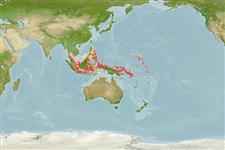Klassifizierung / Names
Namen | Synonyme | Catalog of Fishes(Gattung, Arten) | ITIS | CoL | WoRMS | Cloffa
>
Ophidiiformes (Cusk eels) >
Dinematichthyidae (Viviparous brotula)
Etymology: Diancistrus: Greek, di = two + Greek, agkistron = hook (Ref. 45335); altidorsalis: Name from Latin 'altus' meaning high and 'dorsalis' meaning neck, referring to its high-necked profile..
More on authors: Schwarzhans, Møller & Nielsen.
Environment: milieu / climate zone / depth range / distribution range
Ökologie
seewasser riff-verbunden; tiefenbereich 15 - 20 m (Ref. 57884). Tropical
Verbreitung
Länder | FAO Gebiete | Ecosystems | Vorkommen | Point map | Einführungen | Faunafri
Western Pacific: Indonesia, New Guinea, Sabah to the Solomons, including Sta. Cruz Islands.
Size / Gewicht / Alter
Maturity: Lm ? range ? - ? cm
Max length : 10.2 cm SL Männchen/unbestimmt; (Ref. 57884)
Kurzbeschreibung
Morphologie | Morphometrie
Rückenflossenweichstrahlen (insgesamt): 76-85; Afterflossenweichstrahlen: 59 - 68; Wirbelzahl: 43 - 45. Diagnosis: Vertebrae 11+32-34=43-45, dorsal fin rays 76-85, anal fin rays 59-68; eyes large (at least 2.5% SL); outer pseudoclasper large, broad, ear-lobe shaped; inner pseudoclasper a fleshy appendix at the anterior-inner rim of the outer pseudoclasper, without supporter; large scale patch on operculum above opercular spine (6–9 scales) and 1 to 3 isolated scales below opercular spine; head profile strongly ‘high-necked / hump-backed’; color yellow in live specimens (Ref. 57884).
Large dominating individuals were observed to make attacks toward smaller fish, which were hiding below rocks or any other shelter provided. One male was observed to flip backward the cover of the copulatory organ so that the organ can be exposed while swimming (Ref. 57884). Solitary inhabitant of coral reef crevices to at least 20m depth, cryptic (Ref 90102).
Life cycle and mating behavior
Geschlechtsreife | Fortpflanzung | Ablaichen | Eier | Fecundity | Larven
Schwarzhans, W., P.R. Møller and J.G. Nielsen, 2005. Review of the Dinematichthyini (Teleostei, Bythitidae) of the Indo-West-Pacific. Part I. Diancistrus and two new genera with 26 new species. The Beagle, Records of the Museum and Art Galleries of the Northern Territory 21:73-163. (Ref. 57884)
IUCN Rote Liste Status (Ref. 130435)
Bedrohung für Menschen
Harmless
Nutzung durch Menschen
Mehr Information
NamenSynonymeMetabolismusRäuberÖkotoxikologieFortpflanzungGeschlechtsreifeAblaichenSpawning aggregationFecundityEierEientwicklung
Alter/GrößeWachstumLänge-GewichtLänge-LängeLängenhäufigkeitenMorphometrieMorphologieLarvenLarven Pop.Dyn.RekrutierungDichteBRUVS
ReferenzenAquakulturAquakultur ProfilZuchtlinienGenetikElectrophoresesVererbbarkeitKrankheitenVerarbeitungNutrientsMass conversion
PartnerBilderStamps, Coins Misc.LauteCiguateraGeschwindigkeitSchwimmstilKiemenoberflächeOtolithsGehirngrößeSehfähigkeit
Tools
Zusatzinformationen
Download XML
Internet Quellen
Estimates based on models
Preferred temperature (Ref.
123201): 27.9 - 29.3, mean 28.8 °C (based on 1452 cells).
Phylogenetic diversity index (Ref.
82804): PD
50 = 0.5000 [Uniqueness, from 0.5 = low to 2.0 = high].
Bayesian length-weight: a=0.00389 (0.00180 - 0.00842), b=3.12 (2.94 - 3.30), in cm total length, based on all LWR estimates for this body shape (Ref.
93245).
Trophic level (Ref.
69278): 3.4 ±0.5 se; based on size and trophs of closest relatives
Fishing Vulnerability (Ref.
59153): Low vulnerability (10 of 100).
